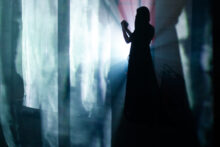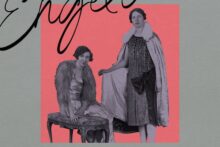“It was in darkest Russia. This place called Voronech close to the Ukrainian border. I handed over all these rubles… it felt like some kind of Cold War transaction. I met this guy in the middle of a shopping arcade…”
Dawn Terry laughs as she remembers sourcing the Ukrainian lira – the imposing hurdy-gurdy adjacent instrument – that has (alongside the accordion) been a sonic hallmark of her solo music over the past few years. One of the founding members of mid 00s Newcastle iconoclasts Bong, Terry’s solo work has also long explored the steely hypnotic power of the drone, albeit with markedly different components. The lira is an ancient instrument marked by its deep overtones and unwieldy, near untunable nature. Did she have much practice with the instrument before the clandestine hurdy-gurdy handover, I wonder?
“I’d never played one before actually. I can barely play any of my instruments! I just find a note that I like and keep it going and enjoy it. It was originally used by blind beggars in Ukraine.”
It was that ability to keep a note droning for seriously long durations that initially drew her to the instrument. “As much as I love the accordion, I do have a love-hate thing with having to kind of stop [a note] as you come out and then start again as you go back in,” she explains. “In some senses it’s really lazy because if I could just press a button and it would drone then I’d do that! But it forces invention out of me.”
As anybody who has heard her solo work will attest, serious power comes from the combination of slow building drone work, vocal exhortations and layered loops. A piece such as ‘Shaking Off Mantles Of Air’ builds slowly to epiphanic crescendo, a power that belies – or, more accurately, is bolstered by – her minimalist set up.
“It’s all very improvised. I find a tuning that seems to work and then use the loop pedal, but there are no effects. I love the natural timbre and tone. The vocals layer on top of that foundation. I like having that gradual build and crescendo, the organic field when sound is just building and building, gradually increasing in power.”
Indeed, ‘hypnotic’ and ‘ritualistic’ have been watchwords for much of the music Terry has made, whether her solo work, collaborations with artists like Arianna Mahseyeh or Eye Spirit, or within Bong. Tracing her love of sustained tones back to Joy Division and The Cure as childhood influences, Terry pinpoints the former’s ‘I Remember Nothing’ as particularly potent early listening; particularly the ‘little silences between the notes; the drones; that seemingly ‘ringing’ echo and reverb. Ridiculously powerful. Some of The Cure stuff as well, Pornography in particular – this was when I was 13 or so. 1988.”
But while the introspective brood of Joy Division and The Cure provided early inspiration, there was also something altogether more maximal and fantastical providing early brainfood. As for so many teens growing up in 1980s Britain, Games Workshop gave entry into a world that soon became immersive. “I was massively into it when I was younger,” she says. “Painting their lead figures and White Dwarf magazine – all that stuff. I absolutely loved it. Got awards for it and everything! I actually carried on up to the age of 19 but kind of gave it up when I went to uni and discovered drugs and women!”
By this stage, the wild turbine of extreme metal was also providing influence, although Terry says that she was initially simply “too lazy to learn an instrument” so put ambitions of musical creativity to one side. However, Newcastle’s serious underground scene soon provided vital energy. “For quite a long time I had the attitude of, ‘well I’ll never be able to make music. I don’t practice therefore I can’t make music’. But when I got to Newcastle a band called Jazzfinger played. They’re still one of my favourite bands. They do weird noisy stuff, drones and so on. They were the biggest influence on me, around that time. They were on stage with three tape players; effects and amps. They made this amazing enveloping noise. I’d never heard anything like it. The other thing was they put out CDRs of their music; they didn’t care about labels or practicing and I thought, ‘shit, I can actually do this. I can make music.’ So I started doing the dungeon synth stuff.”
Drawing on the rich seam of Games Workshop imagery alongside a deep-seated appreciation of cranky Norwegian black metal and lo-fi synth murk, Terry’s dungeon synth project – Trollmann Av Ildtoppberg –was born. Its first album was in tribute to Steve Jackson and Ian Livingstone’s much loved Fighting Fantasy series – books enabling readers to choose their own adventure via the help of page prompts, each decision leading to a differing outcome; the series also featured wonderfully lurid and intensely classical metal imagery, like something from deep within the mind of Dio. The project’s name itself is a Norwegian translation of Warlock Of Firetop Mountain, the first book in the series, while 2001’s debut LP The Forest Of Doom – was named after another Fighting Fantasy title..
Trollmann Av Ildtoppberg was thus the result of deeply geeky alchemy – and a refreshingly playful approach to the sometimes ludicrously po-faced Norwegian Black Metal world. For a start, Terry and co-collaborator Mordraneeth decided to do the whole project in Norwegian.
“Both of us were massive nerds and we were massively into black metal,” laughs Terry. “We always found the really bad English in black metal brilliant, so we decided to, um, give something back to that world… by doing a project entirely in really terrible Norwegian. So we just got a Norwegian dictionary: we had absolutely no idea of grammar; so it was that we got revenge on the black metal scene.”
What though, tQ wonders, did the corpse painted, basement dwelling denizens of Bergen and Oslo make of such frippery? “It was pretty funny actually. The guys from…what were they called? Death metal band… begins with an ‘I’ not Incantation or Immolation…it’ll come to me eventually…but anyhow they were a Norwegian band playing Roadburn. We met them there, then they played Newcastle and found it hilarious.”
This playful element also occasionally made itself felt in Terry’s work with Newcastle drone doom mainstays Bong. One of the deepest – and purest – expressions of sustained tone hypnoblast of the mid 00s, Bong saw Terry (alongside bandmates including the absurdly prolific guitarist Mike Vest and drummer Mike Smith) ploughing the Abyssinian depths on records like Mana Yood Sushai (2012) and Stoner Rock (2013); the latter’s album title a tongue in check reference to the reductive bracket the band occasionally found themselves placed in.
“It was way back, you know? Around 2005,” Terry recalls of the band’s formation. “We just smoked shitloads of weed and listened to loads of Electric Wizard and Burning Witch and Sunn O))). We just wanted to play really slow music! That was pretty much it to start with. And we played loads of gigs up here in Newcastle, but it kind of changed when Walter from Roadburn got in touch. That kicked a lot off for us in around 2010.”
Bong were quickly taken to the heart of the quickly burgeoning scene that grew around the vital foundations of Roadburn – a scene that had taken serious root worldwide through the mid to late 2000s. Was she ever shocked by the extent to which the band were revered, though? “I’m still shocked!” she laughs. “I met someone at the weekend actually and we were chatting about music and it was like, ‘Holy shit you were in Bong?!’”
Since the Bong days, Dawn has come out as a trans woman. Given that all music making is, by its very nature, a deeply personal process, how has this affected her creativity? “I’m not sure if it’s a causal effect,” she explains, “more the situation I feel in myself. It’s affected me in being able to make open music. I mean, it’s very much opened me up to who I am – properly – and to not have any secrets or have anything closed off; to be open about everything. I’m always happy to talk to strangers about the trans stuff although it can get me in trouble occasionally!”
In past decades the metal scene had the reputation – not always unfairly – of being a conservative world unaccepting of outside influences. However, of late there have been more and more challenges to the assumptions of what ‘heavy’ actually means – particularly at festivals such as Roadburn and Supersonic where folk and electronic musicians will be programmed alongside more traditional death, doom and drone artists. Think about a death metal crowd in 1994, say, watching Obituary or Morbid Angel and then gladly going over to watch…
“Current 93?” Terry laughs. “Absolutely. I mean: Alison Cotton, say, is incredibly heavy. And I just don’t see a divide between the two worlds at all. At Supersonic nearly an entire day was folky stuff last time and there’s so much crossover with the people that are watching. They’ll go and see a death metal band; then they’ll go and see a folk band. People are so much more open. A good example: I played a gig with a black metal band called Agriculture in The Black Heart in London last year, right? They were given a list of about 10 potential support acts and they all wanted me to support. So I went down to play and I did my weird accordion drone stuff and… everyone was silent and respectful! There were loads of guys with, y’know, full on death metal and Slayer patches and they really enjoyed it.”
Collaboration has been key to some of Terry’s recent projects, not least her deeply atmospheric album made alongside vocalist and cellist Eye Spirit as The White Horse Of The Sun (2021) on Opal Tapes. Comprising four near half-hour drone pieces, it’s a grandiose album of truly epic atmospheric bearing. “That’s one of the albums I’m proudest of,” says Terry. “We’d meet up at practice and just set everything up and set up – the cello and accordion – and leave the tapes recording for literally hours. We did one live performance, which was at Doom Yoga in London.”
Doom Yoga!? Are we right in imagining that is exactly what it says on the tin? “Yeah, pretty much! It’s a live setting with the, what do you call them, the yoga mistress? Yogi? She goes round the room telling people what to do and what positions they’re supposed to be in, while Connie and I are playing our weird cello and accordion stuff.”
And what of Newcastle? As somebody who has been so keyed into the towns underground for so long, does the city still provide inspiration?
“For the size of the city it’s pretty much incomparable in the UK. I mean, maybe somewhere like Bristol would be on similar lines? It’s a small town but the sheer breadth of weird music on offer is incredibly inspiring. Newcastle is great in that you can just play the gigs, not worry about what the trends are, and just make weird music that you like. It’s one of the reasons I’ve been here so long, 31 years now. As soon as I start playing, though – wherever I am – it’s somewhere I love being and something that I slip into easily. It’s my favourite feeling in the world really, to be making a drone; being subsumed into it, it’s beautiful.”
Dawn Terry plays Acid Horse 23-25 May, Barge Inn, Wiltshire. For details, tickets, and the full lineup, click here




